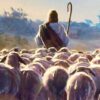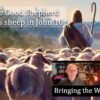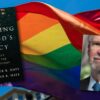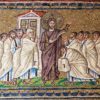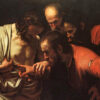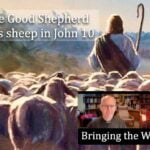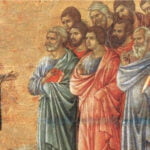My most recent publications are:
- ‘The reimagining of theological time: Revelation’s use of the Old Testament’ in The Scriptures in the Book of Revelation and Apocalyptic Literature.
- ‘The genre of Revelation’ (including two new proposals!) in The Apocalypse of John amongst its Critics.
- The New Testament’s Vision of Mission Grove booklet, exploring key themes from the teaching and practice of Jesus.
- The Practice of Evangelical Spirituality Grove booklet, looking at the seven dimensions of biblical discipleship.
- Exploring the New Testament, Volume Two: Letters and Revelation third edition, fully updated, revised and expanded.
- Revelation: Faithfulness in Testing Times, a series of six studies for individuals or groups.
- Revelation, the Tyndale New Testament Commentary from IVP. (If you order from an online store, make sure you choose mine, not the previous edition by Leon Morris!)
My other recent publications include:
- How to Interpret the Bible: four essential questions (Grove, 2017)
- Being Messy, Being Church (Bible Reading Fellowship, 2017)
- Kingdom, Hope and the End of the World (Grove, 2016)
- The Book of Revelation: currents in British research (Mohr Siebeck, WUNT, 2015)
- Evangelical Leadership: Challenges and Opportunities (Grove, 2016)
Jesus as Good Shepherd leads his sheep in John 10
The lectionary gospel readers for the Fourth Sunday of Easter take the three parts of John 10 in turn; in Year A, we read the first ten verses, and now in Year B we look at the second section in John 10.11–18. But this is a good example of where our modern chapter divisions (first created by Stephen Langton, the 13th-century Archbishop of Canterbury who helped to write the Magna Carta) hinder rather than help our reading, for two reasons.
First, John 10 actually straddles a fairly major division in the narrative. The events of chapter 6 are clearly situated near Bethsaida and around Lake Galilee—the feeding of the 5,000, Jesus walking on the water, and the dispute about Jesus as the bread of life. But in John 7.10, Jesus heads off ‘secretly’ to Jerusalem for the Feast of Tabernacles in the early autumn, one of the three Pilgrim Festivals (with Passover and Pentecost), and the action of chapters 7, 8 and 9 until 10.21 is set around this time. (Note the mention, for example, of the ‘people of Jerusalem’ in John 7.25 and the ‘temple guards’ in John 7.45; this is a reason why we might interpret the language of ‘the Jews’ (Judaioi) here as either ‘Jewish leaders’ or ‘Judeans’.) But in John 10.22, we have now moved to The Feast of Dedication (Hannukah), around two months later, without any note of the time passing. The intense focus on Jerusalem is one of the things that makes sense if we believe that the author of the gospel is a Jerusalem disciple, rather than one of the Galilean Twelve.
Secondly, the chapter change from John 9.41 to 10.1 disrupts the continuity of the narrative, and even breaks up a single speech by Jesus to the Pharisees that oppose him. Chapter 10 begins with the distinctive
Jesus as Good Shepherd leads his sheep in John 10 video discussion
The gospel lectionary reading for Year B is the second part of John 10 (John 10.11-18) on the theme of Jesus as the Good Shepherd, following on from the first…
The Cass report, children, and the Church of England
Dr Hilary Cass has delivered her final report offering an independent review of gender identity services for children and young people. The report is online, and is long and complex…
Is God ‘willing to change his mind’ (Richard Hays) on sexual ethics?
Andrew Goddard writes: There has been much heat surrounding the announcement of a new book on sexuality by Richard Hays and Christopher Hays. What follows attempts to shed some light…
The risen Jesus meets the Eleven in Luke 24
The gospel lectionary reading for the Third Sunday of Easter in Year B is Luke 24.36b–48, the episode where Jesus meets the disciples after the encounter on the Emmaus Road…
The risen Jesus meets the Eleven in Luke 24 video discussion
The reading for Easter 3 in Year B is Luke 24.36b-48 and it looks like the poor relation of last year’s reading, the story of the encounter of the two…
Racial, ethnic, and social diversity in the early church
I cannot quite believe that I first wrote this three years ago; it seems like yesterday. As with the debates on sexuality, the debates on racial justice in the Church…
Do the accounts of the resurrection contradict each other?
If the resurrection of Jesus of Nazareth from the dead is the most important and foundational truth of the Christian faith, how come the New Testament accounts of the resurrection…
What do we learn from ‘doubting’ Thomas in John 20?
The Sunday gospel lectionary reading for the Second Sunday in Easter is John 20.19–31, which includes Jesus’ encounter with so-called ‘doubting Thomas’. It is the set reading for this week…
What can we learn from ‘doubting’ Thomas in John 20? video discussion
The Sunday gospel lectionary reading for the Second Sunday in Easter is John 20.19–31, which includes Jesus’ encounter with so-called ‘doubting Thomas’. It is the set reading for this week…
What makes for Black Success in Britain today?
John Root offers this review of Black Success—The Surprising Truth by Tony Sewell, published earlier this month. Sewell was recently chair of the UK’s government’s Commission on Race and Ethnic Disparities,…

